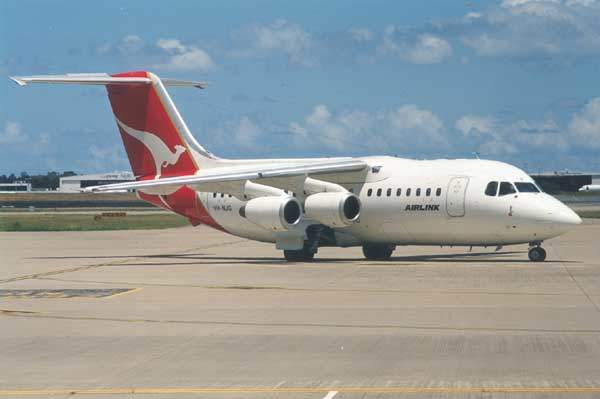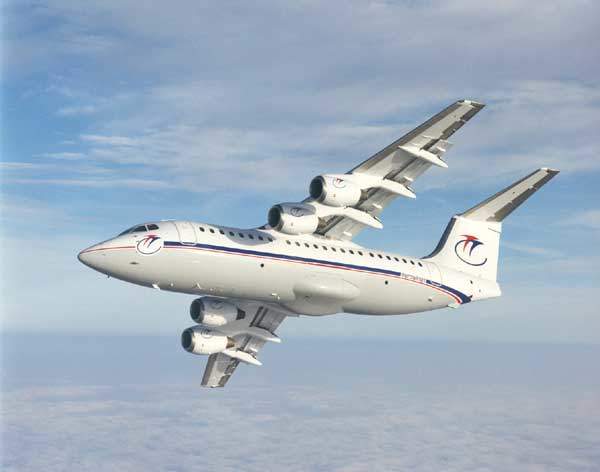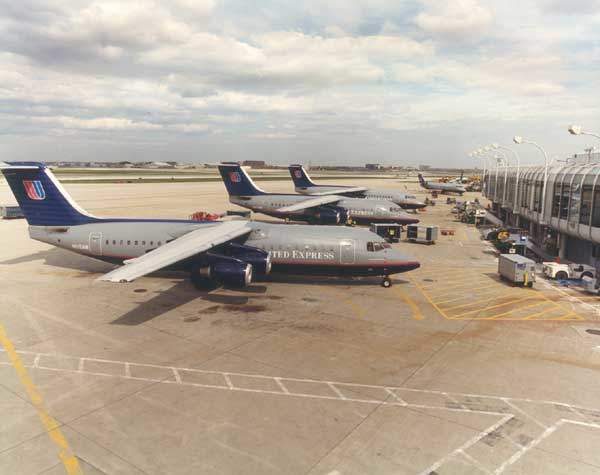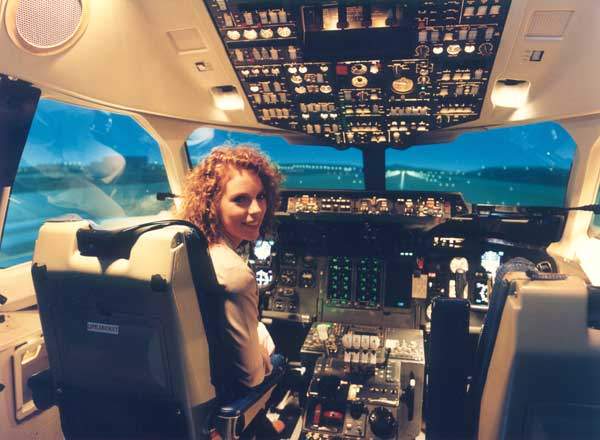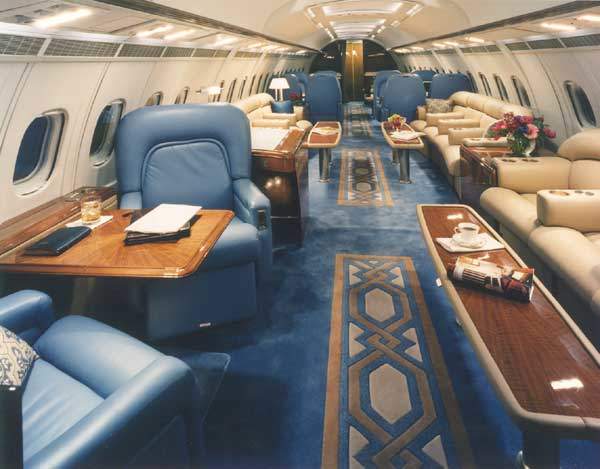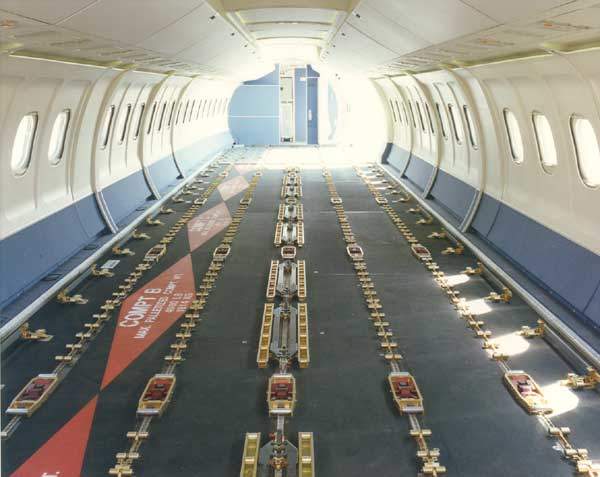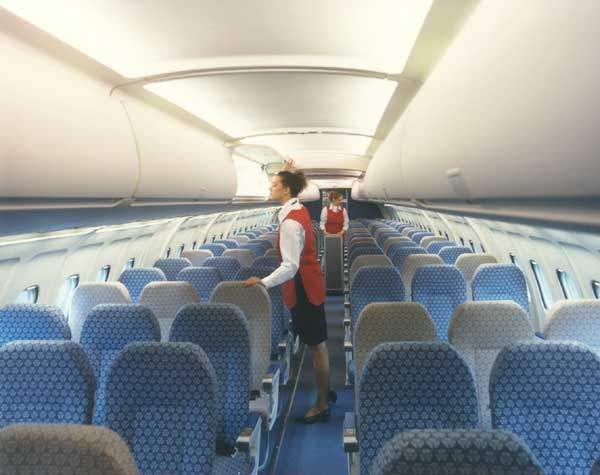The BAE 146 short to medium-range regional airliner is flown by operators worldwide. 229 BAE 146 were built between 1983 and 1993, including the Statesman for the Queens Flight of the Royal Air Force and for the Abu Dhabi Royal Flight. As of August 2010, about 230 aircraft were in service with 60 operators in more than 30 countries worldwide.
Three different length versions of the BAE 146 were built, the series 100 with 70 to 84 seats; the 200 series with 85 to 100 seats; and the 300 series with 100 to 112 seats. The 146 provides versatile and low-noise operation for noise-sensitive approach and take-off paths, the capability of short steep approaches into city airports or onto difficult airfields with minimal ground facilities.
With 97% commonality of equipment and systems, the BAE 146 offers a true family of interchangeable aircraft for efficient fleet planning. The aircraft offers quiet operation and was marketed under the name ‘Whisperjet’. It sees wide usage at small city-based airports. In its primary role, it serves as a regional jet, short-haul airliner or regional airliner.
BAE 146-301 large atmospheric research aircraft G-LUXE is used by the UK’s Facility for Airborne Atmospheric Measurement for gathering data for studies of pollution, global warming, radioactive transfer, tropospheric, cloud physics, mesoscale weather systems, remote sensing, radiometric measurements and as a satellite instrument test-bed.
BAE 146 capacity
The 146 family of aircraft provides seating capacities of 70 to 112 and in the ‘statesman’ configuration various VIP layouts. Passenger access is at both ends of the cabin for fast boarding and disembarkation. The doorsills suit airstairs as well as passenger jetways.
Two baggage holds each equipped with a large access door allow simultaneous loading. The low fuselage means that baggage can be hand loaded directly from trolleys without the need for airport conveyor equipment. The very easy and fast baggage handling contributes to the 146 regularly achieving in-service turnarounds of just 12 minutes.
BAE 146 orders and deliveries
BAE Systems delivered a BAE 146-300 regional jetliner to South Africa based Bionic Aviation in October 2009.
One BAE 146-200 regional jetliner was supplied to PT Aviastar Mandiri on 1 December 2009 during the LIMA ’09 International Maritime and Aerospace Exhibition. The airliner will be operated on behalf of Transnusa Air Services which operates from the Denpasar Airport in Bali.
In December 2009, Titan Airways of UK leased a BAE 146-300 aircraft to meet the requirements of the UK Ministry of Defence in the Middle East. The jetliner will be deployed in Bahrain and fly between Bahrain, Oman and UAE for carrying passengers and cargo.
Aviation Capital Solutions of UK bought five BAE 146-300 regional aircraft on 30 April 2010 to operate in European and African countries. These jetliners will be based in Europe on ACMI (Aircraft, Crew, Maintenance and Insurance) contracts.
African Airlines Investments (AAI), South Africa procured five BAE 146 (Two BAE 146-200 and three BAE 146-300) regional jetliners in May 2010. AAI also has two additional BAE 146-200 aircraft which are currently operating in Gabon and other African countries.
Aerolineas Star Peru procured two BAE 146-200 regional airliners on 3 August 2010. These jetliners are used for domestic services by Aerolineas.
On 5 August 2010, BAE System delivered two BAE 146-200 regional jetliners to Canada-based Avmax International Aircraft Leasing for operation by Regional 1 Airlines.
BAE 146 flight deck
The flight deck is ergonomically designed for two crew operation with the important controls and indicators within reach and view of both pilots. A forward-facing observer seat folds and stows behind the first officer position. The aircraft is fitted with a BAE and Normalair Garrett air conditioning and air pressurisation system and the flight deck is fitted with air conditioning controls separate from those in the main cabin.
The aircraft is equipped with a Honeywell electronic flight instrumentation system, (EFIS) with a Smiths LED display. The main vertical panel in the flight deck houses the engine instruments and the systems controls and indicators are installed in the overhead panel. The Smiths SEP 10 autopilot and main navigation are set at eye level.
BAE Systems Regional Aircraft is introducing an upgrade to older analogue displays, which will be replaced with five Rockwell Collins FPI-920 LCD. The upgrade involves the removal of the two electromechanical attitude director indicators (ADI), two electromechanical horizontal situation indicators (HSI) and two radio altitude indicators (RAI).
The first customers for the upgrade were Eurowings of Germany and Air Dolomiti of Italy.
BAE 146 engines
Four turbofan engines, type ALF 502R-5 from Textron Lycoming (now Honeywell), each rated at 31kN are installed in underwing pods. The high bypass ratio fan jet results in the aircraft’s outstandingly low noise operation and gives a ground footprint for approach and take-off less than half the area than a typical twin-turboprop aircraft.
BAE 146 landing gear
The aircraft is fitted with the large landing gear. The dual-rate shock absorbers and wide wheel track give stable handling in crosswinds and when taxiing. The tricycle-type landing gear designed by Dowty is hydraulically retractable. The twin Dunlop wheels on each unit can be fitted with optional low-pressure tyres for operation from unpaved, low bearing airstrips or from semi-prepared strips. The aircraft is fitted with multi-disc carbon brakes with brake cooling fans on the axles.
BAE 146 ground operations
The auxiliary power unit, GTCP 36-150, supplied by Garrett-AiResearch is installed in a fireproof bay in the rear fuselage. The APU powered systems, the onboard airstairs and the waist-high baggage holds allow the 146 aircraft to be completely independent of the ground services. Only the refuelling operation requires ground equipment, i.e. step ladders. All other service points and service hatches, including the baggage hold access are accessible from ground level.
BAE 146QT (quiet trader) freighter
Approximately 30 BAE 146QT and QC (quick change) freighter aircraft were originally built and converted new off the production line in the mid-late 1980s. Cobham Aviation Services acquired two BAE 146-300QT (Quiet Trader) freighter in July 2010. The aircraft has a strengthened floor and a rear freight door. A safety bulkhead rated at 9g is installed immediately aft of the forward passenger and service doors. The aircraft can accommodate pallets or can be converted for the carriage of livestock, for example up to ten horses and nine grooms in a 300-QT aircraft.
The aircraft carries Class E cargo compartment certification, which with a 10ft (3.05m) underwing clearance allows easy access by tractors and dolly trains. The BAE 146QT aircraft in service achieve turnaround times of less than ten minutes.
Cobham Aviation Services of Australia is currently operating three BAE 146QT for Australia air Express (AaE), which transports 20,000t of freight every year on high-capacity, high-priority overnight services connecting to Brisbane, Sydney, Melbourne and Adelaide cities.
Two freighter conversion programmes for the BAE 146, with Pemco World Air Services of Alabama and Hireplane Cargo Conversions (with Cranfield Aerospace) of the UK, were unsuccessful and the conversion programme was closed down.
In July 2007, the programme was relaunched with Aerostar of Romania responsible for the conversion. The first flight of the relaunched BAe 146QT was in June 2008. The customer, Amerer Air of Austria, cancelled the order and the aircraft is being remarketed. Conversion of a second aircraft is underway.
A BAE 146 tanker conversion was developed by Minden Air, with BAE Systems Regional Aircraft, for firefighting operations. The aircraft was test-flown for evaluation by the US Forest Service.
BAE 146 crashes
More than half a dozen crashes were reported in the BAE 146 category. In 1991 in Chile, a BAe 146-200A overran the runway and killed 20 of the 73 people on board, and in April 2009 an aircraft crashed at Pike Mountain, on approach to Wamena Airport in Indonesia killing six crew members on board.
BAE 146 performance
The BAE 146 can fly at a maximum speed of 801km/h. The cruise and stall speed of the airliner are 546km/h and 189km/h respectively. The range of the aircraft is 2,909km. The take-off and landing run are 1,509m and 1,103m respectively. The aircraft weighs around 23,897kg and its maximum take-off weight is 42,184kg.

